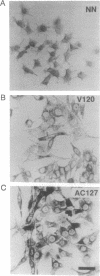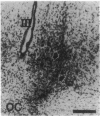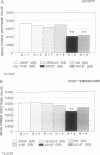Abstract
Alzheimer disease patients exhibit irregularities in the patterns of normally circadian (daily) rhythms. Alzheimer-type pathology has been reported in the hypothalamus and in the suprachiasmatic nuclei, the putative site of the circadian oscillator. We examined the relationship between the neuropathology of Alzheimer disease, as modeled by an animal system, and circadian dysregulation by grafting genetically transformed cells that overexpress beta/A4 amyloid into the suprachiasmatic nuclei of adult rats. Grafts of beta/A4-positive cells, but not of control cells, significantly altered the pattern of activity of implanted rats. Although experimental conditions included light-dark cycles that normally tend to drive rats to 24-h rhythms, animals with grafts of beta/A4-positive cells showed abnormally high levels of activity during the light phase in addition to a disrupted circadian pattern. Periodogram analysis demonstrated significant rhythms outside of a circadian range. The body temperature rhythm of these animals was also weak 6 weeks after grafting; however, unlike activity patterns, body temperature regained a circadian period by 8 weeks after cell implantation. These data indicate that disruption of circadian activity is a behavioral measure of the consequences of beta/A4 accumulation in brain implants.
Full text
PDF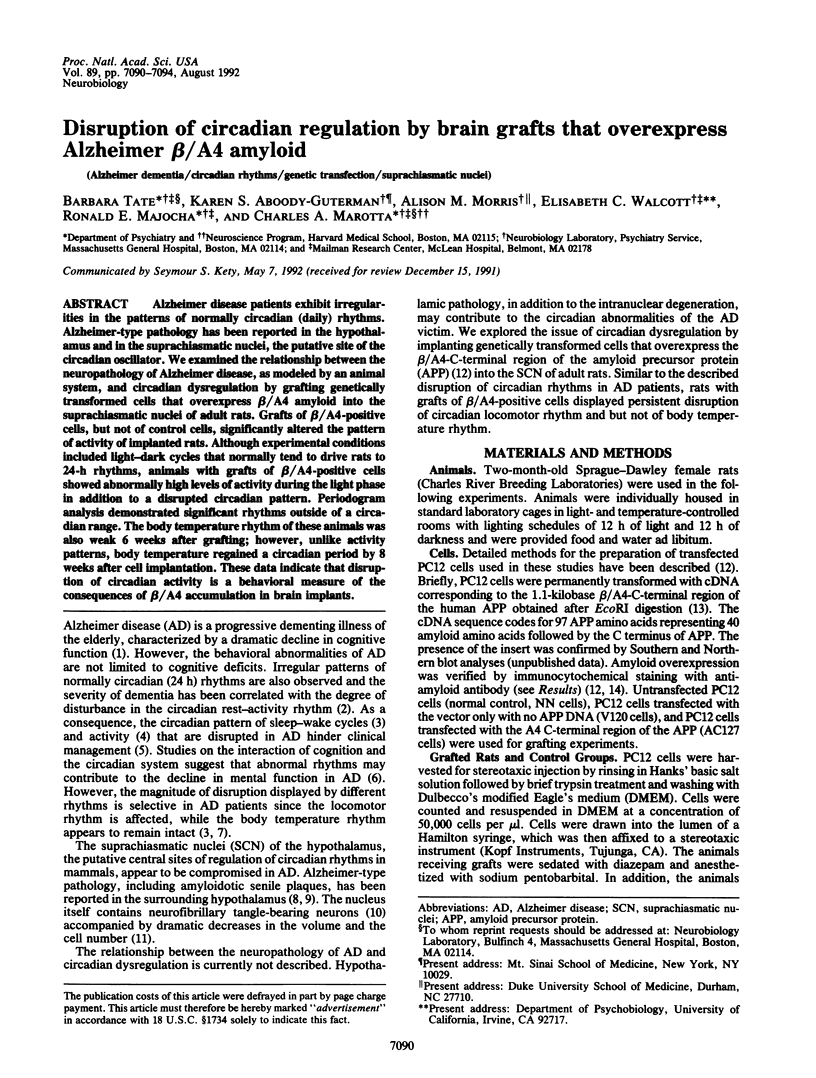

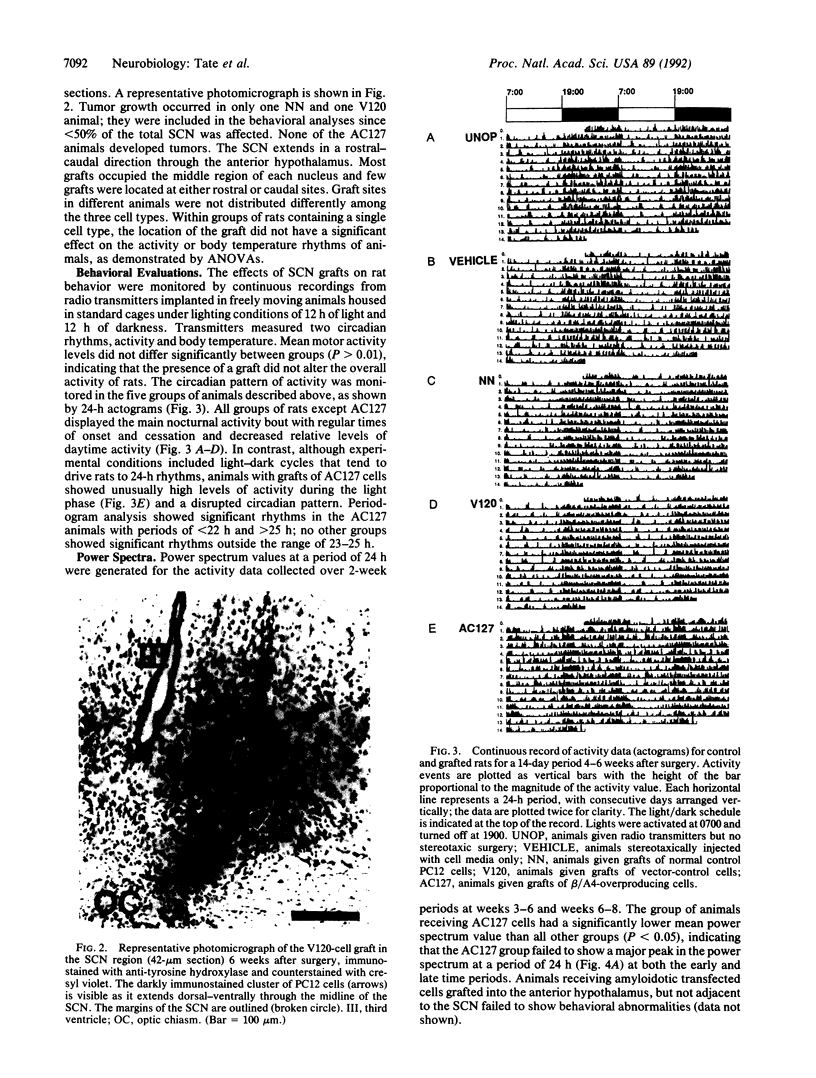
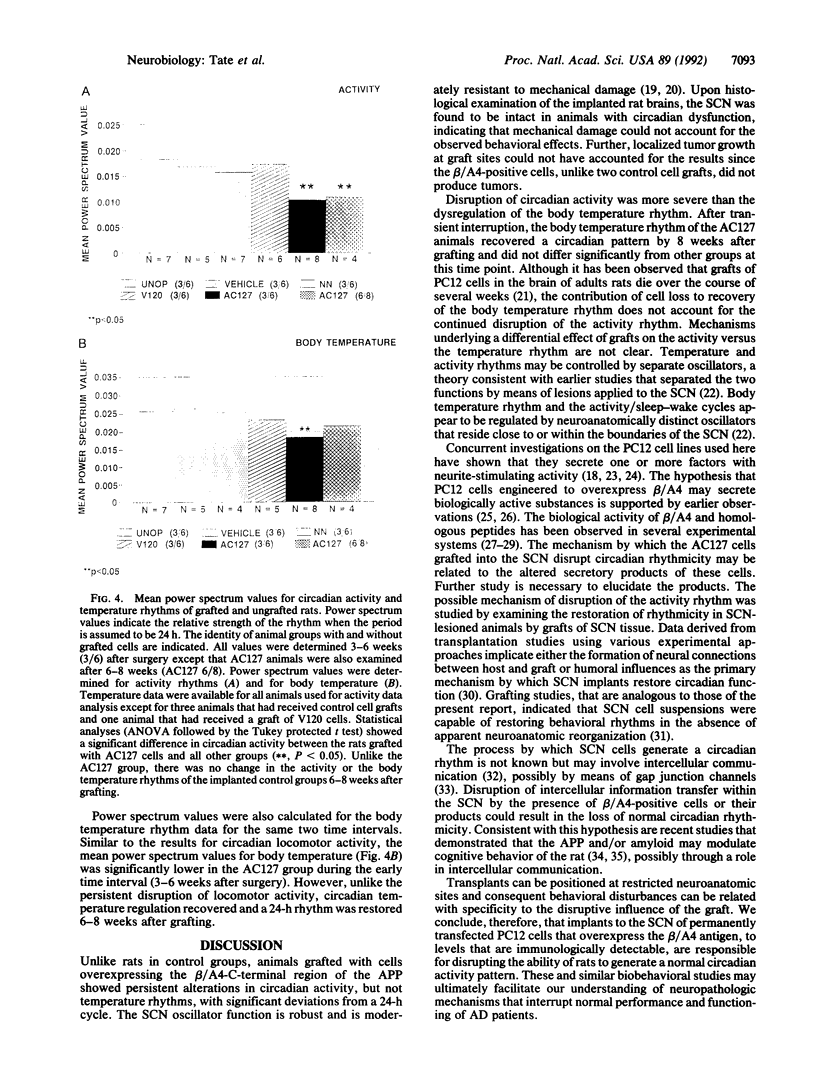
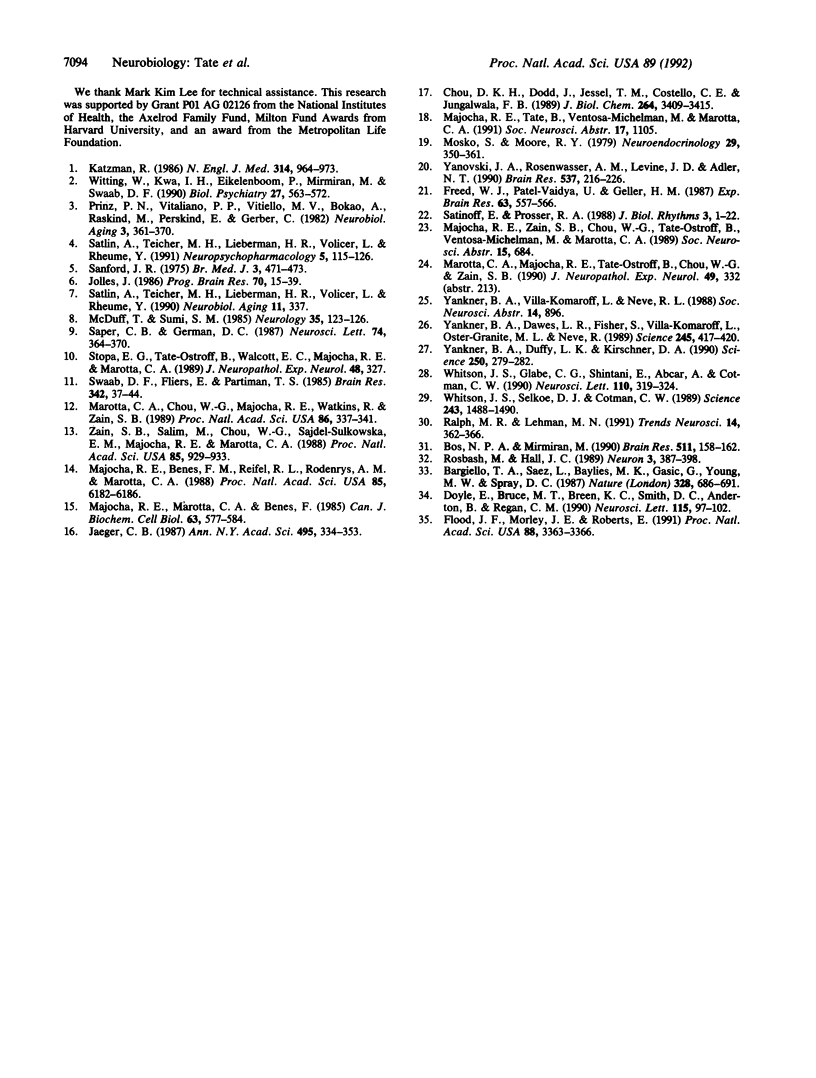
Images in this article
Selected References
These references are in PubMed. This may not be the complete list of references from this article.
- Bargiello T. A., Saez L., Baylies M. K., Gasic G., Young M. W., Spray D. C. The Drosophila clock gene per affects intercellular junctional communication. Nature. 1987 Aug 20;328(6132):686–691. doi: 10.1038/328686a0. [DOI] [PubMed] [Google Scholar]
- Bos N. P., Mirmiran M. Circadian rhythms in spontaneous neuronal discharges of the cultured suprachiasmatic nucleus. Brain Res. 1990 Mar 12;511(1):158–162. doi: 10.1016/0006-8993(90)90235-4. [DOI] [PubMed] [Google Scholar]
- Chou D. K., Dodd J., Jessell T. M., Costello C. E., Jungalwala F. B. Identification of alpha-galactose (alpha-fucose)-asialo-GM1 glycolipid expressed by subsets of rat dorsal root ganglion neurons. J Biol Chem. 1989 Feb 25;264(6):3409–3415. [PubMed] [Google Scholar]
- Doyle E., Bruce M. T., Breen K. C., Smith D. C., Anderton B., Regan C. M. Intraventricular infusions of antibodies to amyloid-beta-protein precursor impair the acquisition of a passive avoidance response in the rat. Neurosci Lett. 1990 Jul 17;115(1):97–102. doi: 10.1016/0304-3940(90)90524-d. [DOI] [PubMed] [Google Scholar]
- Flood J. F., Morley J. E., Roberts E. Amnestic effects in mice of four synthetic peptides homologous to amyloid beta protein from patients with Alzheimer disease. Proc Natl Acad Sci U S A. 1991 Apr 15;88(8):3363–3366. doi: 10.1073/pnas.88.8.3363. [DOI] [PMC free article] [PubMed] [Google Scholar]
- Freed W. J., Patel-Vaidya U., Geller H. M. Properties of PC12 pheochromocytoma cells transplanted to the adult rat brain. Exp Brain Res. 1986;63(3):557–566. doi: 10.1007/BF00237478. [DOI] [PubMed] [Google Scholar]
- Jaeger C. B. Morphological and immunocytochemical characteristics of PC12 cell grafts in rat brain. Ann N Y Acad Sci. 1987;495:334–350. doi: 10.1111/j.1749-6632.1987.tb23684.x. [DOI] [PubMed] [Google Scholar]
- Jolles J. Cognitive, emotional and behavioral dysfunctions in aging and dementia. Prog Brain Res. 1986;70:15–39. doi: 10.1016/s0079-6123(08)64295-8. [DOI] [PubMed] [Google Scholar]
- Katzman R. Alzheimer's disease. N Engl J Med. 1986 Apr 10;314(15):964–973. doi: 10.1056/NEJM198604103141506. [DOI] [PubMed] [Google Scholar]
- Majocha R. E., Benes F. M., Reifel J. L., Rodenrys A. M., Marotta C. A. Laminar-specific distribution and infrastructural detail of amyloid in the Alzheimer disease cortex visualized by computer-enhanced imaging of epitopes recognized by monoclonal antibodies. Proc Natl Acad Sci U S A. 1988 Aug;85(16):6182–6186. doi: 10.1073/pnas.85.16.6182. [DOI] [PMC free article] [PubMed] [Google Scholar]
- Majocha R. E., Marotta C. A., Benes F. M. Immunostaining of neurofilament protein in human postmortem cortex: a sensitive and specific approach to the pattern analysis of human cortical cytoarchitecture. Can J Biochem Cell Biol. 1985 Jun;63(6):577–584. doi: 10.1139/o85-076. [DOI] [PubMed] [Google Scholar]
- Marotta C. A., Chou W. G., Majocha R. E., Watkins R., LaBonne C., Zain S. B. Overexpression of amyloid precursor protein A4 (beta-amyloid) immunoreactivity in genetically transformed cells: implications for a cellular model of Alzheimer amyloidosis. Proc Natl Acad Sci U S A. 1989 Jan;86(1):337–341. doi: 10.1073/pnas.86.1.337. [DOI] [PMC free article] [PubMed] [Google Scholar]
- McDuff T., Sumi S. M. Subcortical degeneration in Alzheimer's disease. Neurology. 1985 Jan;35(1):123–126. doi: 10.1212/wnl.35.1.123. [DOI] [PubMed] [Google Scholar]
- Mosko S. S., Moore R. Y. Neonatal ablation of the suprachiasmatic nucleus. Effects on the development of the pituitary-gonadal axis in the female rat. Neuroendocrinology. 1979;29(5):350–361. doi: 10.1159/000122944. [DOI] [PubMed] [Google Scholar]
- Prinz P. N., Vitaliano P. P., Vitiello M. V., Bokan J., Raskind M., Peskind E., Gerber C. Sleep, EEG and mental function changes in senile dementia of the Alzheimer's type. Neurobiol Aging. 1982 Winter;3(4):361–370. doi: 10.1016/0197-4580(82)90024-0. [DOI] [PubMed] [Google Scholar]
- Ralph M. R., Lehman M. N. Transplantation: a new tool in the analysis of the mammalian hypothalamic circadian pacemaker. Trends Neurosci. 1991 Aug;14(8):362–366. doi: 10.1016/0166-2236(91)90164-p. [DOI] [PubMed] [Google Scholar]
- Rosbash M., Hall J. C. The molecular biology of circadian rhythms. Neuron. 1989 Oct;3(4):387–398. doi: 10.1016/0896-6273(89)90199-2. [DOI] [PubMed] [Google Scholar]
- Sanford J. R. Tolerance of debility in elderly dependants by supporters at home: its significance for hospital practice. Br Med J. 1975 Aug 23;3(5981):471–473. doi: 10.1136/bmj.3.5981.471. [DOI] [PMC free article] [PubMed] [Google Scholar]
- Saper C. B., German D. C. Hypothalamic pathology in Alzheimer's disease. Neurosci Lett. 1987 Mar 9;74(3):364–370. doi: 10.1016/0304-3940(87)90325-9. [DOI] [PubMed] [Google Scholar]
- Satinoff E., Prosser R. A. Suprachiasmatic nuclear lesions eliminate circadian rhythms of drinking and activity, but not of body temperature, in male rats. J Biol Rhythms. 1988 Spring;3(1):1–22. doi: 10.1177/074873048800300101. [DOI] [PubMed] [Google Scholar]
- Satlin A., Teicher M. H., Lieberman H. R., Baldessarini R. J., Volicer L., Rheaume Y. Circadian locomotor activity rhythms in Alzheimer's disease. Neuropsychopharmacology. 1991 Sep;5(2):115–126. [PubMed] [Google Scholar]
- Swaab D. F., Fliers E., Partiman T. S. The suprachiasmatic nucleus of the human brain in relation to sex, age and senile dementia. Brain Res. 1985 Sep 2;342(1):37–44. doi: 10.1016/0006-8993(85)91350-2. [DOI] [PubMed] [Google Scholar]
- Whitson J. S., Glabe C. G., Shintani E., Abcar A., Cotman C. W. Beta-amyloid protein promotes neuritic branching in hippocampal cultures. Neurosci Lett. 1990 Mar 14;110(3):319–324. doi: 10.1016/0304-3940(90)90867-9. [DOI] [PubMed] [Google Scholar]
- Whitson J. S., Selkoe D. J., Cotman C. W. Amyloid beta protein enhances the survival of hippocampal neurons in vitro. Science. 1989 Mar 17;243(4897):1488–1490. doi: 10.1126/science.2928783. [DOI] [PubMed] [Google Scholar]
- Witting W., Kwa I. H., Eikelenboom P., Mirmiran M., Swaab D. F. Alterations in the circadian rest-activity rhythm in aging and Alzheimer's disease. Biol Psychiatry. 1990 Mar 15;27(6):563–572. doi: 10.1016/0006-3223(90)90523-5. [DOI] [PubMed] [Google Scholar]
- Yankner B. A., Dawes L. R., Fisher S., Villa-Komaroff L., Oster-Granite M. L., Neve R. L. Neurotoxicity of a fragment of the amyloid precursor associated with Alzheimer's disease. Science. 1989 Jul 28;245(4916):417–420. doi: 10.1126/science.2474201. [DOI] [PubMed] [Google Scholar]
- Yankner B. A., Duffy L. K., Kirschner D. A. Neurotrophic and neurotoxic effects of amyloid beta protein: reversal by tachykinin neuropeptides. Science. 1990 Oct 12;250(4978):279–282. doi: 10.1126/science.2218531. [DOI] [PubMed] [Google Scholar]
- Yanovski J. A., Rosenwasser A. M., Levine J. D., Adler N. T. The circadian activity rhythms of rats with mid- and parasagittal 'split-SCN' knife cuts and pinealectomy. Brain Res. 1990 Dec 24;537(1-2):216–226. doi: 10.1016/0006-8993(90)90361-e. [DOI] [PubMed] [Google Scholar]
- Zain S. B., Salim M., Chou W. G., Sajdel-Sulkowska E. M., Majocha R. E., Marotta C. A. Molecular cloning of amyloid cDNA derived from mRNA of the Alzheimer disease brain: coding and noncoding regions of the fetal precursor mRNA are expressed in the cortex. Proc Natl Acad Sci U S A. 1988 Feb;85(3):929–933. doi: 10.1073/pnas.85.3.929. [DOI] [PMC free article] [PubMed] [Google Scholar]



